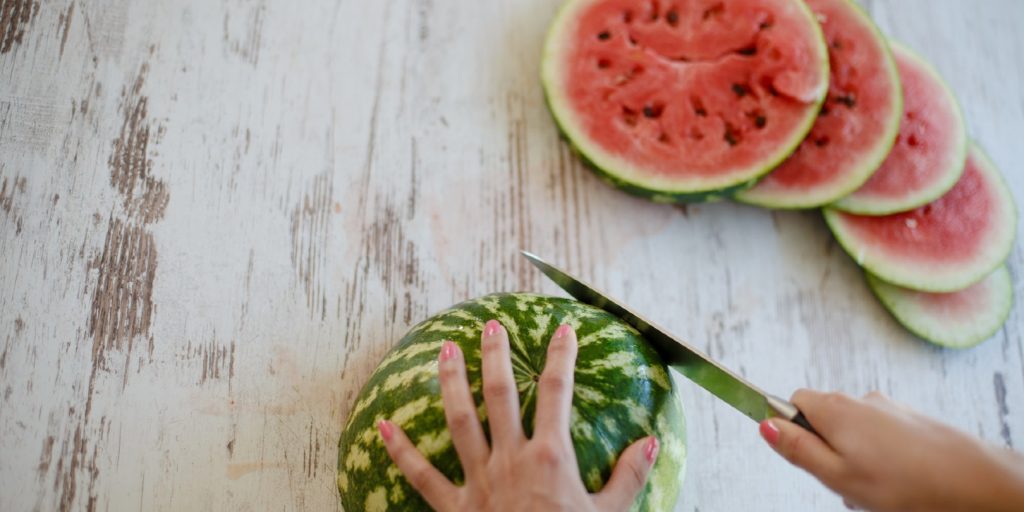We’ve Tried Everything, Here’s the Easiest Way To Cut a Watermelon

Are you tired of struggling to cut a watermelon? Do you dread the mess that comes with slicing it traditionally? Well, don’t worry, because we’ve got the solution. In this article, we will share the easiest way to cut and serve a watermelon—yes, it’s that simple!
We’ve done the research and testing, so you don’t have to spend more time figuring out how to cut a watermelon. Ultimately, you’ll have beautiful wedges perfect for eating or serving. Plus, you won’t have more watermelon juice all over your countertops. So what are you waiting for? Read on for more information and get to cutting this delicious fruit today!
Selecting the Right Watermelon
When selecting a watermelon, there are specific things you need to look for. The rind should be firm, and there shouldn’t be any bruises, bumps, or soft spots. Most importantly, it should feel heavy for its size and have a crisp sound when tapped firmly. When you look at the color, it should have deep green and lighter streaks across it. The color should also be consistent throughout the fruit with minimal yellow. Lastly, check for a white powdery material called “bloom,” which means the melon was harvested at peak maturity and is sweet and juicy.
To pick the perfect watermelon, examine its shape and look for symmetry. It should be oval-shaped with relatively even ends; any variation in size can tell you whether or not it has been exposed to too much sun or too little water. The next step is to turn over and inspect the bottom side; it should be creamy yellow or white with no green patches or black spots. Lastly, flip it back over and confirm that it has an all-over light yellow hue; this indicates that it’s ripe and will have proper sweetness.
Prepping the Watermelon
Now that you’ve selected your watermelon, let’s start prepping! Begin by rinsing the rind of the watermelon with tap water to get rid of any dirt or bacteria; this step is especially important if you plan on serving it cut up into cubes or slices later. Next, with a knife, make two lengthwise cuts about three inches apart from each end of the watermelon; then use a spoon or melon baller to scoop out any remaining seeds before proceeding with slicing fully through both cuts that you made at each end of your watermelon, making sure that your knife enters through just one side of your previously made cuts. Now, you’re ready to start slicing!
Cutting and Serving the Watermelon
Start making thin slices in either direction (usually going in one direction looks neater) by placing your knife against one edge of the rind as close as possible and pushing downwards until your knife reaches the other edge in one smooth motion. Continue doing this until all of the melon has been sliced up into pieces, around ¼ inch thick each. Finally, gently remove each slice from its rind, starting from one end of the melon and going to the other until all slices are removed from their rinds. Feel free to experiment with different shapes, such as triangles, or use a melon baller for uniform circular shapes!
Some alternatives are available if you want to get creative with cutting your watermelon! For instance, instead of slicing down each side with a knife, you can also use a round cookie or biscuit cutter for formed shapes such as stars or hearts! Alternatively, cutting crosswise instead of lengthwise will give you round slices that can easily be divided into wedges by cutting them twice diagonally!
Storing the Watermelon
Proper storage is key if you save some of your delicious watermelons for later consumption! For an uncut watermelon, wrap it in plastic wrap and place it in an airtight container in the refrigerator for up to 1 week; however, keep in mind that freezing damages taste and texture, so we recommend only storing uncut melons in cold temperatures like this if necessary only, such as if they were harvested too early before peak maturity. When harvested correctly, they will usually last 3-5 days out on the countertop at room temperature if kept covered with a damp cloth if needed during hotter climates with higher humidity levels than usual. For cut watermelon, store in an airtight container, separating slices by wrapping damp paper towels between each slice before storing in the refrigerator. This will help keep moisture levels stable and maintain freshness longer than using regular plastic wrap alone, which often prevents airflow, only lasting 2-3 days maximum under ideal storage conditions — though usually only one day realistically depending on the environment.
For storing cubed watermelons, grab an airtight container after cubing. Fill the container halfway with ice cubes, then pour the remaining cubed melon inside. Add more ice cubes if needed, and store in the refrigerator for up to 4 days. If needed, shake out excess moisture periodically by gently scooping out cubes onto a paper towel before returning them to an airtight container. This will help maintain freshness levels longer than just regular plastic wrap alone. If needed, drape a damp cloth over the cubed melon while keeping it in chilly temperatures, as this will help maintain cubed freshness even longer. A melon baller is optional but recommended for smaller-sized cubes.